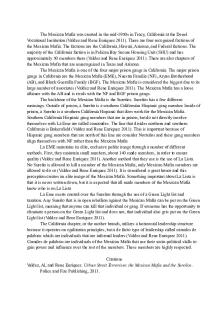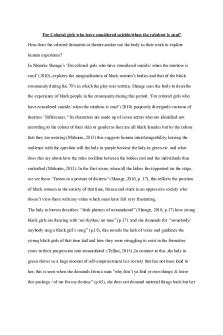Week 2 Post - Week 2 Post PDF

| Title | Week 2 Post - Week 2 Post |
|---|---|
| Course | Prison Gangs |
| Institution | University of California Irvine |
| Pages | 1 |
| File Size | 59.7 KB |
| File Type | |
| Total Downloads | 2 |
| Total Views | 178 |
Summary
Week 2 Post...
Description
The Mexican Mafia was created in the mid-1950s in Tracy, California at the Deuel Vocational Institution (Valdez and Rene Enriquez 2011). There are four recognized factions of the Mexican Mafia. The factions are the California, Hawaii, Arizona, and Federal factions. The majority of the California faction is in Pelican Bay Secure Housing Unit (SHU) and has approximately 50 members there (Valdez and Rene Enriquez 2011). There are also chapters of the Mexican Mafia that are unrecognized in Texas and Arizona. The Mexican Mafia is one of the four major prison gangs in California. The major prison gangs in California are the Mexican Mafia (EME), Nuestra Familia (NF), Aryan Brotherhood (AB), and Black Guerrilla Family (BGF). The Mexican Mafia is considered the biggest due to its large number of associates (Valdez and Rene Enriquez 2011). The Mexican Mafia has a loose alliance with the AB and is rivals with the NF and BGF prison gangs. The backbone of the Mexican Mafia is the Sureños. Sureños has a few different meanings. Outside of prison, a Sureño is a southern Californian Hispanic gang member. Inside of prison, a Sureño is a southern California Hispanic that does work for the Mexican Mafia. Southern California Hispanic gang members that are in prison, but do not directly involve themselves with La Eme are called camarades. The line that divides northern and southern California is Bakersfield (Valdez and Rene Enriquez 2011). This is important because of Hispanic gang members that are north of this line are consider Norteños and these gang members align themselves with NF rather than the Mexican Mafia La EME maintains its elite, exclusive public image through a number of different methods. First, they maintain small numbers, about 140 made members, in order to ensure quality (Valdez and Rene Enriquez 2011). Another method that they use is the use of La Lista. No Sureño is allowed to kill a member of the Mexican Mafia, only Mexican Mafia members are allowed to do so (Valdez and Rene Enriquez 2011). It is considered a great honor and this perception creates an elite image of the Mexican Mafia. Something important about La Lista is that it is never written down, but it is expected that all made members of the Mexican Mafia know who is on La Lista La Eme exerts control over the Sureños through the use of a Green Light list and taxation. Any Sureño that is in open rebellion against the Mexican Mafia can be put on the Green Light list, meaning that anyone can kill that individual or gang. If someone has the opportunity to eliminate a person on the Green Light list and does not, that individual also gets put on the Green Light list (Valdez and Rene Enriquez 2011). The California chapter, or the mother branch, utilizes a horizontal leadership structure because it operates on egalitarian principles, but a de facto type of leadership called carnales de palabras which are individuals that are informal leaders (Valdez and Rene Enriquez 2011). Carnales de palabras are individuals of the Mexican Mafia that use their socio-political skills to gain power and influence over the rest of the members. These members are highly respected. Citations Valdez, Al, and Rene Enriquez. Urban Street Terrorism: the Mexican Mafia and the Sureños. Police and Fire Publishing, 2011....
Similar Free PDFs

Week 2 Post - Week 2 Post
- 1 Pages

WEEK 2 DIscussion Post
- 1 Pages

Week 1 Discussion Post
- 1 Pages

MSN 560 Week 3 Peer Post 2
- 1 Pages

Week 3 - discussion post
- 1 Pages

Informatics week 1 post
- 2 Pages

Week 1 Forum Post
- 11 Pages

Blog post #2 - post 2 online
- 1 Pages

Week 1 - week 1 discussion post
- 4 Pages

Week 4 Nursing theory Post
- 1 Pages

Week 2 - week 2
- 4 Pages

Week 2 - week 2
- 12 Pages
Popular Institutions
- Tinajero National High School - Annex
- Politeknik Caltex Riau
- Yokohama City University
- SGT University
- University of Al-Qadisiyah
- Divine Word College of Vigan
- Techniek College Rotterdam
- Universidade de Santiago
- Universiti Teknologi MARA Cawangan Johor Kampus Pasir Gudang
- Poltekkes Kemenkes Yogyakarta
- Baguio City National High School
- Colegio san marcos
- preparatoria uno
- Centro de Bachillerato Tecnológico Industrial y de Servicios No. 107
- Dalian Maritime University
- Quang Trung Secondary School
- Colegio Tecnológico en Informática
- Corporación Regional de Educación Superior
- Grupo CEDVA
- Dar Al Uloom University
- Centro de Estudios Preuniversitarios de la Universidad Nacional de Ingeniería
- 上智大学
- Aakash International School, Nuna Majara
- San Felipe Neri Catholic School
- Kang Chiao International School - New Taipei City
- Misamis Occidental National High School
- Institución Educativa Escuela Normal Juan Ladrilleros
- Kolehiyo ng Pantukan
- Batanes State College
- Instituto Continental
- Sekolah Menengah Kejuruan Kesehatan Kaltara (Tarakan)
- Colegio de La Inmaculada Concepcion - Cebu



